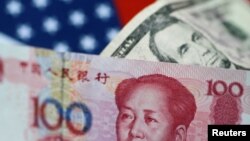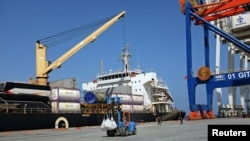Officials in Pakistan say a Chinese proposal to replace the U.S. dollar with yuan for bilateral trade is under consideration.
Beijing has already committed to investing around $60 billion in the country by 2030 under a long-term plan of development cooperation with Islamabad, known as the China Pakistan Economic Corridor, or CPEC.
Bilateral trade between the two countries stood at around $14 billion in 2015 to 2016. Officials anticipate the trade volume is likely to increase significantly under ongoing CPEC cooperation.
Pakistan Interior Minister Ahsan Iqbal, who has also been overseeing CPEC implementation, revealed for the first time this week China is seeking bilateral trade in its own currency, known as Renminbi, RMB, or yuan.
“We are examining the use of RMB instead of the U.S. dollar for trade between the two countries,” Iqbal said and added the use of Chinese currency would benefit Pakistan. But he went on to explain the Pakistani currency would be used domestically.
The State Bank of Pakistan has already declared Yuan as an approved foreign exchange for all purposes in the country.
China is helping Pakistan build power plants, develop the southwestern port of Gwadar on the Arabian Sea, construct a network of roads, rails and communications, industrial parks, agriculture and tourism along the CPEC route.
CPEC investment
The two countries launched CPEC in 2015 when Chinese President Xi Jinping visited Pakistan to sign a number of agreements initially estimated at around $46 billion.
“I am happy to say that so far more than $27 billion worth of investment has been energized. It is either under implementation on ground or its financing has been secured,” Iqbal told a ceremony Monday in Islamabad while unveiling details of the long-term plan under CPEC.
He praised the investment as “one of the great success stories” of recent times that within such a short period of time so much investment has been mobilized between any two countries.
China has declared CPEC as the flagship project of its Belt and Road Initiative that aims to build new land and maritime trade routes connecting more than 60 countries in Asia, Europe and Africa.
Chinese investment has already seen completion of several power plants in Pakistan, where energy shortages, until recently, would lead to power outages of up to 20 hours a day in parts of the country.
Chinese and Pakistani officials say the crisis is being resolved and there will be even surplus power in the coming few months in Pakistan.
CPEC will ultimately link landlocked western Chinese regions to Gwadar port, giving Beijing a secure and much shorter access through Pakistan to import fuel and export products to markets in Asia, Europe and Africa, in return for bringing infrastructure and economic development in Pakistan and addressing its energy crisis.








